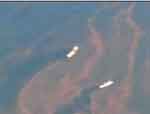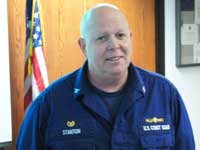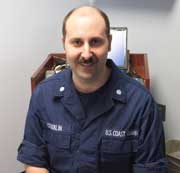SLD visited U.S. Coast Guard facilities in the New Orleans area as well as attending the keel laying for the new Sentinel Class Patrol Boats at the Bollinger Yards. Unfortunately, recent developments in the Gulf would demonstrate once again the importance of the USCG to the nation. This sector, with other USCG sectors, is facing significant challenges from resource shortfalls. We discussed all of the various mission areas with our USCG interlocutors, but we have provided only some of the excerpts from the wide-ranging and frank interview with Captain Ed Stanton and Commander Stocklin.

Captain of the Port of New Orleans, Captain Ed Stanton is currently also commander of the unified command center, which has been set up on the outskirts of Houma, south of New Orleans to manage the oil spill response in the area: BP, the Coast Guard and state and federal agencies have indeed been gathering resources to deal with the crisis.
The Challenges Facing the New Orleans Sector: An Interview with Captain Stanton, Sector Commander, New Orleans Sector, and Commander P. M. “Bo” Stocklin, Jr., Chief Contingency Planning and Force Readiness, New Orleans Sector
[slidepress gallery=’uscg-new-orleans’]

SLD: Could you explain the focus of your activity in the New Orleans sector?
Captain Stanton: Sectors are alike organizationally, but because of their geography, the work focus is unique to each sector. They’re all very different. For example, Miami is heavily counter-drug counter-migrant and cruise ship. New Orleans is heavily maritime safety, outer continental shelf, and river. It’s a 300– mile long port. New York is the UN, a lot of airport security, 30 congressional districts, and not as much shipping activity.
SLD: What is the major focus of Search and Rescue (SAR) in your sector?
Commander Stocklin: With regard to SAR, there’s a lot on Lake Pontchartrain. We’ve got a good location with station New Orleans to cover that. Also, we’ve got a good deal of offshore SAR where we’ve got stations in Venice and Grand Isle to respond, but their boats can only go 30 nautical miles offshore safely for a SAR response. It’s a bit more of a challenge over on this far Western side of the AOR, because our small boats from the stations don’t have very long legs, and we’re constrained with our 87 foot patrol boats.
The 87-foot boats are assets that are so handy for us, because they work so well in a variety of mission areas. We tend to overuse them quite frankly because we have to. For SAR where they’re outside of the station coverage, they’re the only thing we’ve got other than aircraft.
For doing security activities, any time it’s rough going out the mouth of the river, we have to use the cutters, because the station boats are too small to get there.
Search and rescue is an area where we work particularly closely with a lot of our state and local partners. State wildlife fisheries, local sheriff’s departments, they really collaborate a lot with us on the search and rescue mission.
Captain Stanton: Also, SAR really for us also covers the wetlands. We have a lot of wetlands and estuary and a lot of shallow water. Forty-ones and twenty-fives (boats) can’t go to most of the areas where we have SARs. So the air station becomes a critical piece, helicopters are especially important as are the local agencies because they have air boats.
So we rely heavily on the sheriff’s departments, fish and wildlife service, both from Louisiana wildlife—department of wildlife issues and the national fish and wildlife folks for their air boats. The NOAA surveys on this area for coastal surveys are over 100 years old. So, if there’s not a depth marked on the chart, we’re not by policy even supposed to go there. We will, if it’s critical, and no other asset is available, but a lot of this is just too shallow for our boats.
So helicopters are really important for search and rescue in this area. Two weeks ago we had a tanker offshore that lost propulsion and was loaded with crude oil. They were drifting down within four miles of one of the largest oil platforms in the Gulf, which was an access, a hub, for about 20 different pipelines : we had nothing out there. There is no way we could get there. Luckily the Gulf is full of offshore supply vessels and one put a line on it and was able to nudge it far enough, change its vector, drift just enough to get it past the platform.
So we rely on luck and other people’s resources all the time.
SLD: But luck may be useful in getting a result, but not a good planning guide. Clearly, the new cargo and tanker ships are getting bigger and the challenges grow with them. I see little national focus on this challenge associated with global economic growth.
Captain Stanton: You are right, the vessels are getting bigger. The activity is getting bigger, because they have to go farther into the Gulf. That’s where most of the active drilling is now. What has not been tapped yet is the natural gas resource in the Gulf because of the price. The price is depressed. So they’re not doing any exploration of production on natural gas. But when that happens, we will see the much larger Liquefied Natural Gas (LNG) vessels populating the Gulf.
SLD: Maritime safety is obviously a big part of your activity here as well. Could you describe your efforts in this area?

Commander Stocklin: Just the sheer volume is something to note here. We have over 5,200 vessel arrivals –this is deep draft vessels every year. 93% of that is foreign flag. So that equates to a very heavy port state control workload.
Our focus is to go on board and do all the safety inspections on foreign flag vessels. In addition, we have the security workload of vetting them before hand, and we have to decide selectively who needs a security boarding. So safety and security are kind of a one, two punch for us.
In addition to the foreign flag deep drafts, we have over 2,500 domestic vessel inspections per year. That’s everything from the offshore supply boats, to barges carrying oil and hazardous material. So that’s huge.
And we also have to do facility inspections. Those are our refineries, chemical plants, anything that’s required to have a security plan by MTSA. Not only the number itself is large but we have some of the largest refineries and chemical plants in the country on this stretch of river. We approve their security plans and we have to actually do on site inspections. I think it’s at least once a year, and additionally we’re out there doing spot checks on a random basis.
SLD: Given your limited resources, the significant demand, I cannot imagine you can do anything other than a risk based approach to security management.
Captain Stanton: We try and take a risk based, strategic approach. And we work significantly with partners in the private sector as well as the local law enforcement sector as well. We look for things like cameras that can be shared on websites up and down the river in kind of a regional security network. We look for the ports themselves to buy security boats that can be used up and down the river.
SLD: Your inland waterways challenge seems complicated by the age and nature of the boats you have available to do the missions.
Captain Stanton: From the mouth of the river to Baton Rouge, I don’t believe there is a single boat ramp nor is a marina that dispenses gasoline. So our 25 foot boats are completely inappropriate for the tasks simply because they can’t go very far up the river. We use them right here in the city because they come from the Lake [Lake Pontchartrain]. It takes them an hour and a half to get from my station on the lake to the river before the security escort on a cruise ship for instance. And while they’re doing that, it’s a two-boat requirement, so there’s no SAR coverage on Lake Pontchartrain and the USCG auxiliary must step up and take over the SAR.
We try to leverage everybody because of resource constraints. We have police boats and police authority, state police, and the Louisiana Department of Wildlife and Fisheries and the sheriff’s department to help us out. We could not function effectively without them.
***
In the two videos below, Captain Stanton explains the challenges posed by the size and geographical nature of the New Orleans Sector. He underscores that, “we are very resource strained. We have to surge our resources all over our AOR [Area Of Responsability]; cooperation with many other organizations is vital.”
Video # 1 : The Range of the Challenge
Video # 2 : The Scarcity of Resources
———-
*** Posted on May 7th, 2010

